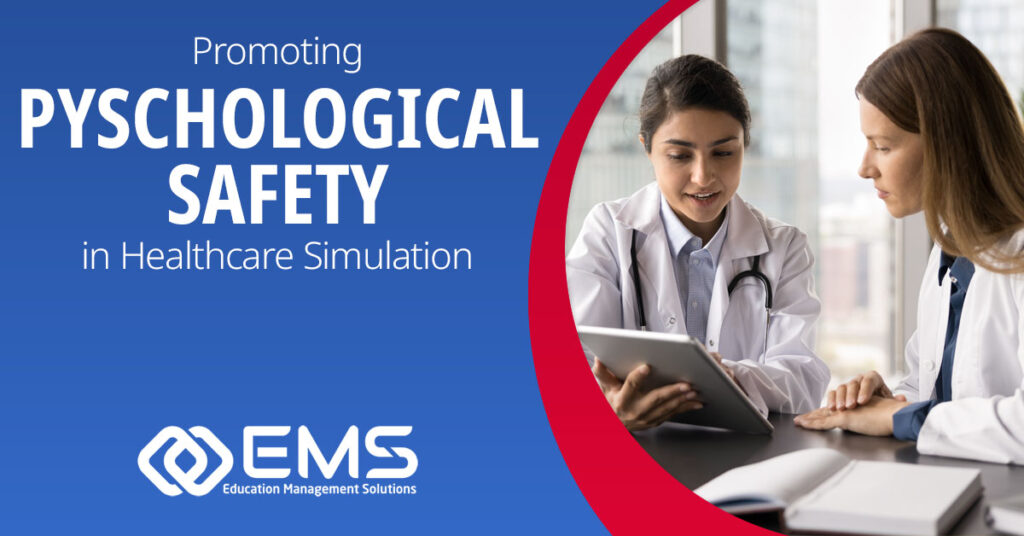Creating a psychologically safe learning environment during simulation-based training is an important component of fostering an effective educational experience, improving learner confidence, and ensuring the successful application of learned skills in real-world scenarios. Psychological safety in healthcare simulations goes beyond reducing anxiety or stress – it involves constructing a space where healthcare students are empowered to engage, ask questions, admit mistakes, and refine their skills without fear of judgment.
By focusing on implementing targeted strategies that leverage specific soft-touch tactics and judicially employing technological aids, healthcare educators, government agencies, and higher education institutions can create environments that not only meet training objectives but also enhance professional and clinical outcomes through safe and healthy instructional surroundings.
The Importance of Psychological Safety in Simulation Learning
Psychological safety, first formalized by Dr. Amy Edmondson of Harvard University, is defined as a shared belief that a team environment is safe for interpersonal risk-taking. In the context of healthcare simulation, this means learners feel safe to participate actively without fear of embarrassment, retaliation, or being dismissed.
Research from the Journal of Healthcare Simulation1 emphasizes that psychologically safe environments improve learner engagement, decrease performance anxiety, and enhance critical decision-making under pressure. For healthcare educators, investing in psychological safety during simulation-based training aligns directly with better skills retention, higher learner satisfaction, and ultimately better patient care outcomes.
Strategies for Promoting Psychological Safety in Healthcare Simulation
1. Foster Effective Pre-Briefing Sessions
The pre-briefing stage is vital for setting the tone of the simulation experience. Clear communication of objectives, expectations, and guidelines ensures learners know what type of instruction they are about to engage in and reassures them that mistakes are treated as opportunities for growth. Tools like simulation management platforms with debriefing and feedback systems can help facilitate structured pre-brief sessions, allowing educators to standardize this process across all simulation events.
This pre-definition of expectations of learning events can lead to better results. According to an article from Advances in Simulation2, participants are more likely to engage actively in learning opportunities when they know the simulation environment is designed for collaborative learning and reflection.
2. Normalize Errors as Part of the Learning Process
Mistakes are intrinsic to learning, especially in simulation training where real-life consequences are mitigated. Educators should proactively remind learners that errors made during simulations are acceptable and valuable for improvement. In this way, debriefing will then allow learners to analyze their decisions objectively, helping them identify errors constructively and understand their implications without undue pressure.
3. Create a Neutral Feedback Environment
Constructive feedback is the cornerstone of simulation-based education, but traditional critiques can inadvertently discourage learners if not managed appropriately. Psychological safety requires that feedback is delivered in a neutral, nonjudgmental manner.
If educators provide evidence-based feedback tied directly to performance metrics captured during the simulation, this evidence-based critique may further bolster trust and acceptance of feedback. Furthermore, this data-driven approach ostensibly removes subjectivity and focuses the conversation on measurable outcomes and actionable improvements, making critical responses both transparent and educational.
4. Encourage Peer Collaboration
In simulations that involve team-based scenarios, fostering psychological safety across all participants is of utmost importance. Peer collaboration works best when learners feel they can rely on each other for support rather than judgment. Educators can accomplish this by emphasizing collective learning over individual performance during pre-briefing and throughout the simulation experience.
5. Educator Professional Development
To create a psychologically safe simulation environment, educators themselves need to possess the skills and mindset required to support this initiative. Offering facilitator training that prioritizes emotional intelligence, cultural sensitivity, and unbiased communication helps educators foster the right environment for their learners.
Psychological Safety in Simulation Training is Continuous
Promoting psychological safety in healthcare simulations is not a passive process; it requires intentional strategies, robust tools, and continuous educational support. By fostering environments where learners are encouraged to explore, engage, and learn without fear, healthcare institutions and educators can significantly enhance the effectiveness of their simulation programs.
Ready to elevate your simulation program? Contact EMS today to learn more about how our solutions can help you design safer, stronger, and more cost-effective training environments.

